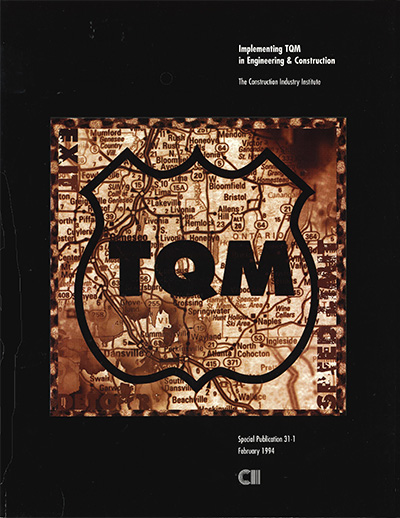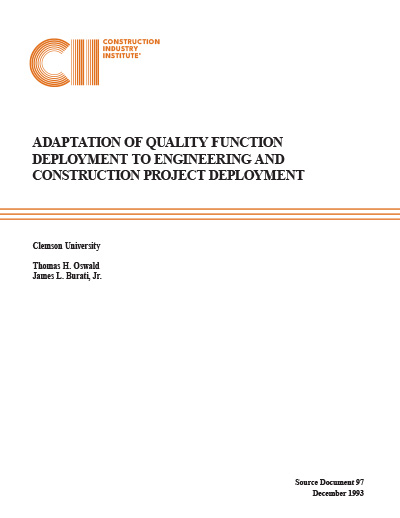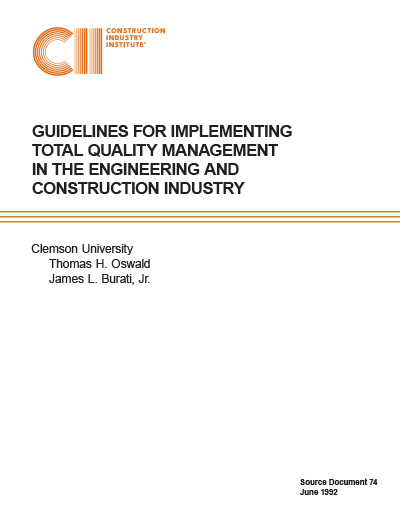
Implementing TQM in Engineering & Construction
“Companies must institute Total Quality Management (TQM) or become noncompetitive in the national and international construction and engineering markets within the next five to ten years.”
CII Quality Management Task Force
April 1990
“The major policy change accompanying our Quality Management (QM) implementation is that of declaring QM to be the way we manage the business and the way that our contractors and suppliers will be expected to manage theirs.”
Head of Engineering, Owner Company
August 1991
This publication is based on comprehensive interviews of 17 major companies involved in the E&C industry: eight owners and nine contractors. Their TQM experience has ranged from four to ten years.
The material in this publication consists of background text along with accompanying graphics (Appendix D) for use in presentations. Specifically, the text and accompanying graphics can be used to:
- Obtain senior management’s attention regarding their role in and the potential benefits of TQM implementation.
- Provide guidance for an owner or E&C contractor firm that is beginning its TQM journey.
- Assess the current status and progress for a firm that is already active in its TQM implementation efforts.
- Help an owner or contractor by providing a document with guidance to assist subcontractors and suppliers in beginning a TQM process of their own.
Four major areas were identified as among the most significant factors for successful TQM implementation. The publication addresses these factors that are essential for successful TQM implementation:
- TQM implementation roadmap
- Critical role of management
- TQM training
- Results of implementing TQM
There is no universal, “cookbook” approach, although a general sequence of four implementation phases seems to produce the best results. This publication describes this sequence by using a roadmap analogy. Lessons learned from more experienced engineering and construction TQM practitioners are shown as either success factors or pitfalls and barriers.
The TQM Implementation Roadmap is a guide for management in charting the course for TQM implementation, and in understanding its full implications before embarking the organization on the journey. In following the roadmap, senior management must personally and persistently lead the building of quality values into the company’s operations. If this does not happen, quality improvement does not happen. Senior management also must ensure that TQM is connected to the external customer and to the business results of the company.
TQM training is different from the training traditionally engaged in by E&C companies in several ways:
- There is a new mix of subject matter (group dynamics, team skills).
- There is a new vocabulary (alignment, facilitation) to be learned.
- There are different situations (team meetings, feedback sessions) for applying the training.
- The audience is company-wide, both vertically and horizontally.
TQM training must be planned and managed if it is to be successful. Most firms have employed a cascade approach, with respect to both audience and subject matter, to TQM training. Training has been successfully conducted from the top down with respect to audience, and in the content sequence of quality awareness, quality improvement tools, and team skills.
For successful implementation, top management must be convinced of the benefits of TQM. The last chapter presents information on the results and benefits of successful implementation of TQM in the interviewed firms. These successes include both financial and subjective benefits attributed to TQM. These success stories should be helpful in convincing managers of the potential benefits to be gained from TQM implementation in their companies.
The TQM Implementation Roadmap – TQM is described as a journey not a definition because the improvement process never ends. The TQM Implementation Roadmap includes 4 major phases.
- Phase I, Exploration and Commitment Phase – The key in this phase is identifying the need and providing the training necessary for TQM implementation.
- Phase II: Planning and Preparation – The keys identified for this phase include selection of the deployment process, training implementation at various levels, and team selection and commissioning process.
- Phase III: Implementation – Phase III success factors include formation of a steering team, realignment in the award systems, chartering QI teams, continued training, Pilot teams, and rolling out the process based on pilot results.
- Phase IV: Sustaining – Key factors in this phase include conversion of QI results to standard procedures, continuation of planning, improvement process, management commitment, training, and active management oversight.
The TQM Roadmap provides step-by-step guidelines for successfully implementing TQM in the E&C industry. These guidelines are based on the experiences of the interviewed firms and represent the most likely path to TQM success.



